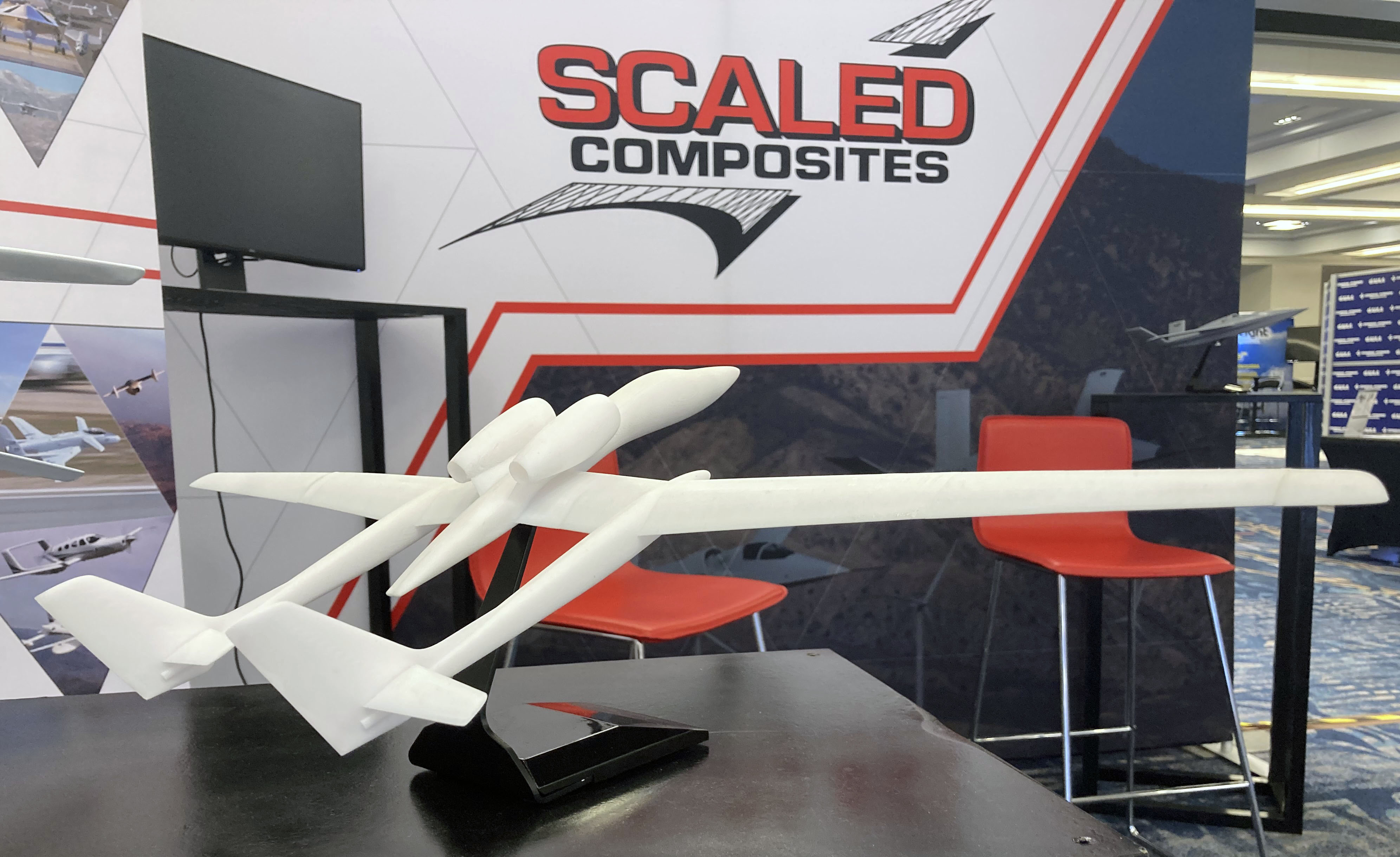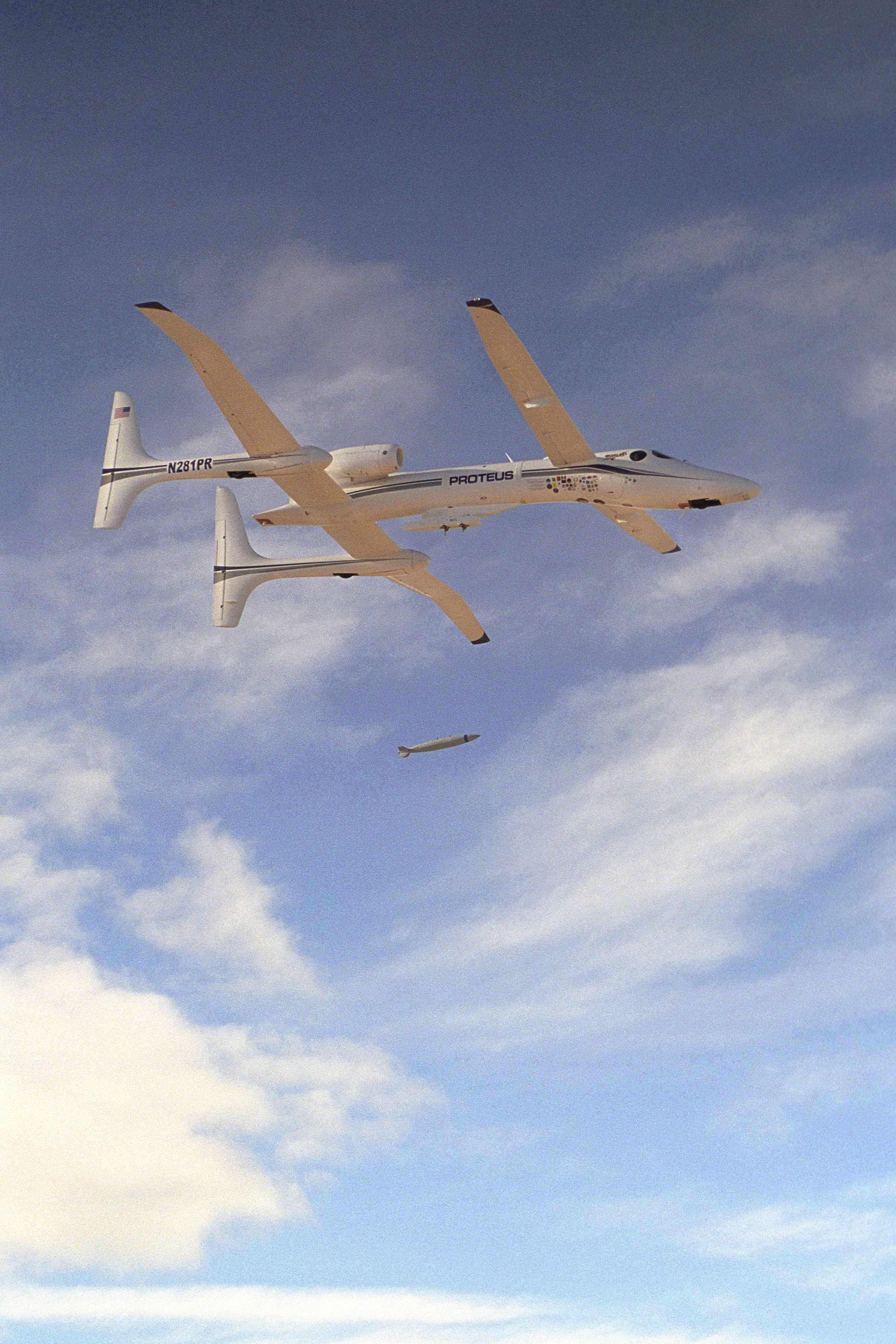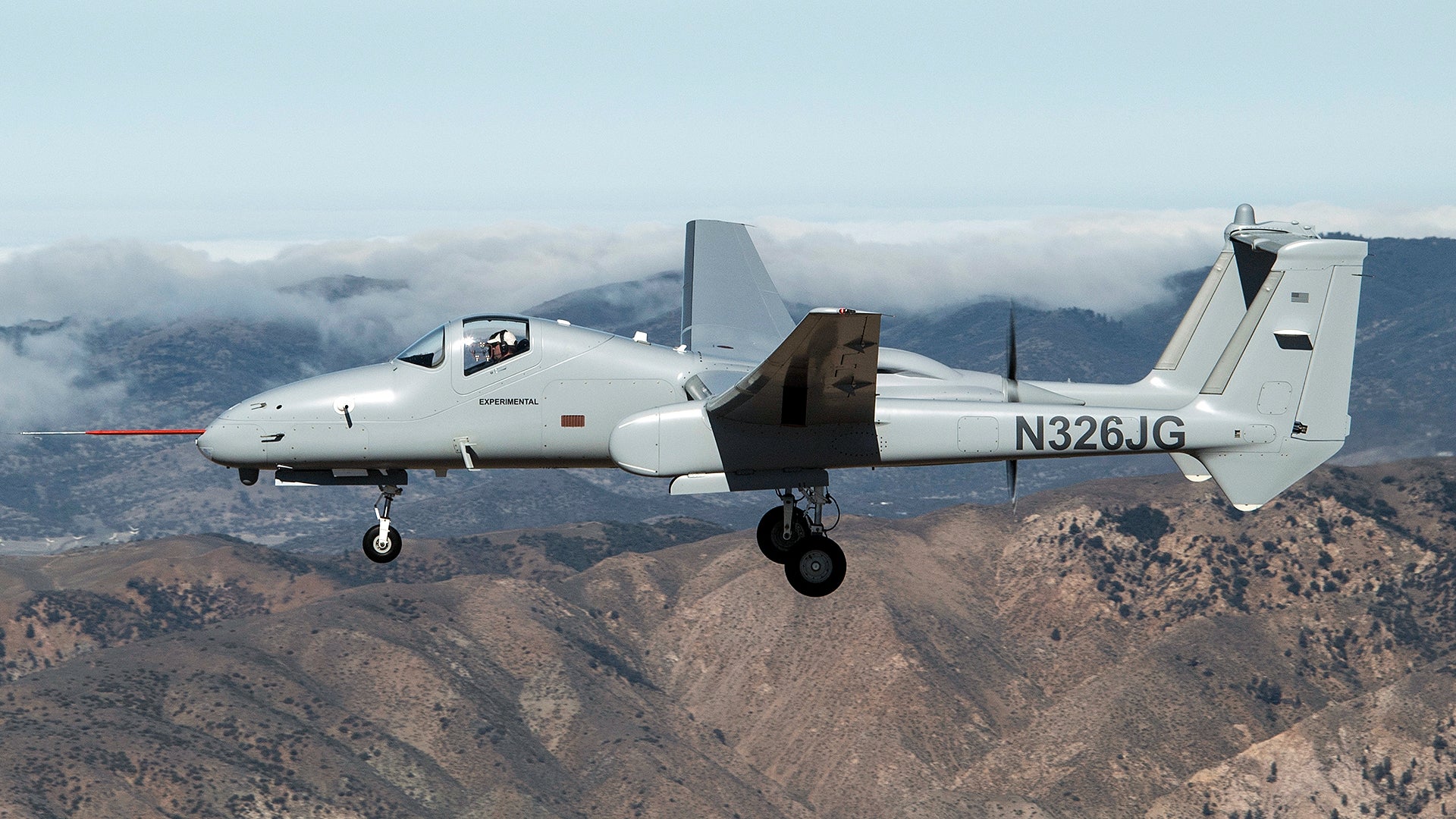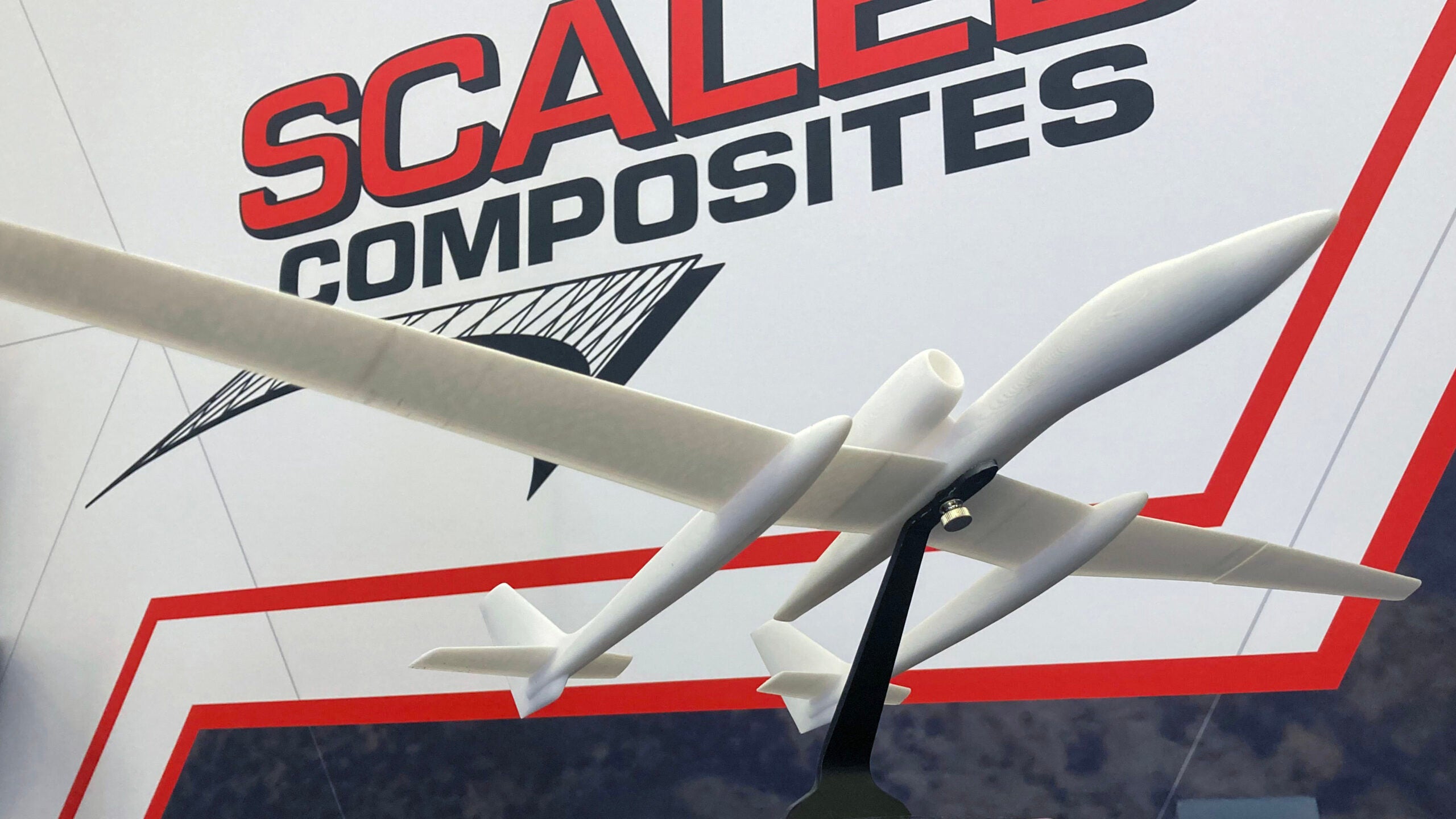A new design from Scaled Composites, the Model 412 Encore, has appeared for the first time in 3D-printed model form. The company has told us that the Model 412 Encore is currently a white paper concept in the “preliminary design phase,” that it has already been pitching the concept to a number of interested customers, and is now looking for funding to continue development, including a flying prototype. Moreover, the emergence of the concept, which is optionally manned, reflects the innovative company’s growing portfolio of modular designs that can be reconfigured for various mission sets — the Encore is anticipated as being used for a number of mission sets or as a testbed.
The public’s first look at the Encore was provided by a desktop model shown on the Scaled Composites booth at the AIAA SciTech Forum and Exposition that’s currently taking place in San Diego, California, as well as online. The Encore is displayed next to a model of the same company’s one-off Proteus, a manned high-altitude test platform that has flown numerous experimental missions since its first flight in 1998. Since then, Mojave-based Scaled Composites has become a subsidiary of Northrop Grumman.

Like the Proteus, the Model 412 is optimized for high-altitude performance, flying missions at up to 70,000 feet, compared to up to 65,000 feet for the same company’s Proteus. The new aircraft is planned to carry a payload of up to 10,000 pounds which would make it ideal for intelligence, surveillance, and reconnaissance (ISR) missions, as well as various experimental test missions. While we don’t know what the Model 412’s endurance might be, the Proteus is able to remain aloft for the better part of a day.
While clearly influenced by the Proteus, the Model 412 Encore exhibits some notable changes to its basic configuration, replacing the tandem wing of the earlier design with a more conventional single long-span straight wing. It retains the twin tail booms of the Proteus but adds a horizontal stabilizer to each. The powerplant arrangement appears similar, with a pair of engines mounted above the wing on the rear fuselage. The Proteus is powered by two Williams FJ44-3A commercial bizjet engines. The forward part of the fuselage of the Model 412 fuselage is also very similar to that of the Proteus fuselage.

With its single main wing, the Model 412 is in some ways closer in configuration to the Model 318 White Knight. Similarly influenced by the Proteus, the White Knight is used to launch the companion SpaceShipOne experimental suborbital manned spaceship, hauling it to altitude for launch. Unlike the White Knight, the Encore has low-mounted tailplanes, and has lost the protruding gear extensions from the front of the tail booms.

The desktop model of the Encore doesn’t appear to be fitted with any kind of external payload but it’s to be expected that it would adopt the same arrangement as the Proteus. This aircraft has carved a niche for itself thanks to its ability to carry a wide range of payloads in central gondola-like pods.

While the Proteus has carried aloft payloads including rockets, NASA scientific payloads, dummy bombs, and the Multi-Platform Radar Technology Insertion Program radar (MP-RTIP) for the Global Hawk, the Encore’s ISR role would involve it being fitted with a range of likely modular sensor payloads, perhaps including synthetic aperture radar with ground moving target indicator (GMTI) mode, multi-spectral electro-optical sensors, electronic intelligence and other electronic warfare equipment, satellite communications links, and, potentially, weapons.
Intriguingly, we have heard about a military-optimized version of the Proteus in the past. Appearing as a concept in 2004, this was known as the Model 395 and was linked to an armed unmanned aircraft project dubbed Hunter-Killer. Unlike the Model 412, this project was intended to be exclusively unmanned and was closer in overall configuration to the existing Proteus. Trials involving the manned Proteus dropping munitions as a ‘surrogate UAV’ at Nellis Air Force Base, Nevada in 2005 were closely related to this concept. The payload-carrying capability of the Model 395 was expected to allow it to carry munitions up to and including the 5,000-pound laser-guided GBU-28/B bunker-buster bomb. The Model 395 was expected to carry loads weighing up to a total of 6,500 pounds, externally and using its more than 100 cubic feet of unused internal volume.

Although it seems to have ultimately come to naught, the Model 395 concept does hint at the possibility of the new Model 412 being intended to fly armed missions, as well as ISR. At the time that the so-called Hunter-Killer program was being mooted, one Northrop Grumman official described the Model 395 as “a new class of UAV that is less than a Global Hawk and more than a tactical UAV like the Predator A or Heron I.” It’s certainly possible to imagine the Model 412 occupying a similar category.
What’s more, the Model 412’s ability to fly at 65,000 feet would give its weapons extreme range. It would be possible for the Encore to provide armed coverage over a very wide area and also carry the sensors needed for targeting and post-strike reconnaissance at standoff ranges.
There have been some suggestions that the Model 412 might lend itself to the U.S. Air Force initiative known as MQ-Next, a replacement for the current fleet of MQ-9 Reaper drones. While the exact requirements remain undefined, the Model 412 seems an unlikely Reaper replacement, operating at a much higher altitude, closer to that of the manned U-2 spy plane. Scaled Composites also already has the optionally manned Firebird, which is in a broadly similar weight and performance class. Indeed, from an overall functional perspective, the Model 412 would seem to provide a higher-altitude complement to the Firebird in the company portfolio.

While not stealthy, the Model 412 would offer high-altitude and very long-range performance coupled while being cost-effective and able to fly multiple different missions, potentially by only swapping out the payload gondola.
With the Pentagon now working to develop its Joint All-Domain Command and Control architecture, or JADC2, which aims to connect sensors from all U.S. military services into a single network, there also appears to be an emerging need for a drone that can fulfill a command-and-control and networking role. In this way, the Encore could operate on the edges of contested airspace or in non-contested airspace while networking together swarms of unmanned combat air vehicles, as well as share data between a range of other platforms.
Another potential application could be as part of a future airborne laser platform, of the kind that we have talked in depth about in the past. The Missile Defense Agency has already been looking into the potential of mounting a solid-state laser on a high altitude, long-endurance (HALE) unmanned aircraft. Although its timelines for realizing such a system may have stalled, MDA’s original requirements for such a directed-energy drone include flying above 65,000 feet, and loitering for 36 hours at a time, and Encore may well fit the bill going forward.
Finally, it’s worth noting that the U.S. may not be the only intended customer for Encore. In fact, it may not even be the primary intended one. Like its lower and slower-flying Firebird cousin, providing an optionally manned HALE system with modular payload adaptability at an attractive price could open up the capability set to a large swathe of international customers, which could even involve military applications and some commercial or non-military agency work. This could include everything from mapping and environmental monitoring to surveillance and test and evaluation work.
We will be sure to keep a close eye on the next developments in this intriguing program.
Contact the author: thomas@thedrive.com
